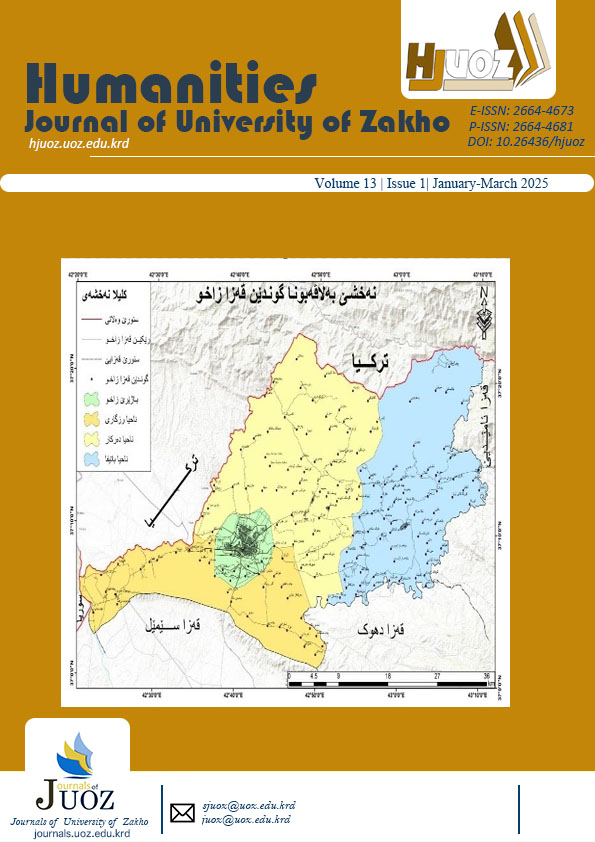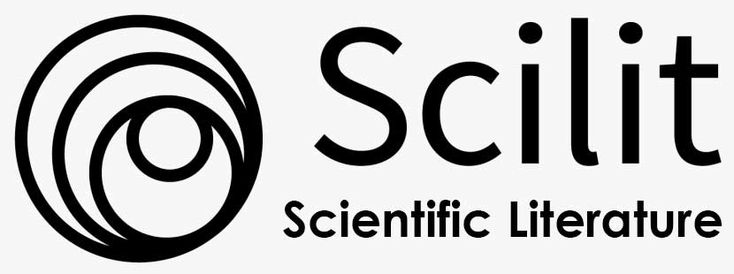THE ROLE OF THE MARDUK GOD IN THE INCANTATIONS TEXTS AND EXORCISM IN MESOPOTAMIA
DOI:
https://doi.org/10.26436/hjuoz.2025.13.1.1513Keywords:
Marduk Gods, Spell Texts, Exorcism, Mesopotamia and SumerianAbstract
The Marduk god is one of the most important main gods in ancient Iraq. His name was mentioned in many Sumerian writings in different forms, and emerged around (2600 BC). Also, he is the protector god of the Babylon city and was given the position of gods king in the Babylon city. The Marduk god played a great role in the Spells texts, as man has imagined himself since ancient times surrounded by all kinds of evil forces that hit him, as a result of committing sins and wrongdoings. Hence, the Mesopotamia inhabitants in their various historical eras believed that the consequences of human illnesses likewise epidemics were the result of the gods' irritation at humans, owing to their committing sins also crimes, and holding humans accountable for the sins and disobediences they commit, and thus evil spirits in addition demons that cause diseases and harm are imposed on them. This is what prompted people to seek the assistance of priests in order to get rid of these diseases and evil spirits through some rituals and religious practices, including spells with the assistance of the concerned gods. The most prominent of these gods specialized in expelling demons and spirits is the Marduk god. The importance of this research comes to show the major role of the Marduk god in spells. In many magical forms, the magician would seek support from the Marduk god in spells to free the sickening person from the grip of evil demons. In addition to his role in healing patients, the role of the Marduk god in fighting evil is evident from the above, as he is the spirit of magic and spells that expels evil represented by jinn and evil spirits from the body of the sickening person. Whereas, others were used to nullify the works of magic and the hazards of demons that triggered harm and diseases to people, including the plague and headaches. Also, this study attempts to explore the most significant diseases that were treated by spells in Mesopotamia, and some of these spells were specific to winds and purification.
Downloads
References
اولاً: المصادر العربية والمترجمة الى العربية:
-احمد، سامي سعيد، (2013)، المعتقدات الدينية في العراق القديم، بيروت، المركز الأكاديمي للأبحاث.
-ادزارد.د، واخرون،(2000)، قاموس الالهة والاساطير، ت:محمد وحيد خياطة، بيروت، دار الشرق العربي.
-بلاك، جريمي، كريين، أنتوني، (2020)، القاموس المصور الآلهة، الشياطين والرموز لبلاد الرافدين القديم، ت: منذر علي عبد الملك، مطبعة المتحف البريطاني.
-حنون، نائل، (1986)، عقائد ما بعد الموت في حضارة بلاد وادي الرافدين القديمة، ط2، بغداد، دار الشؤون الثقافية العامة.
-الدوري، رياض عبد الرحمن امين، (2009)، السحر في العراق القديم في ضوء المصادر المسمارية، بغداد، دار المثنى.
-رشيد، فوزي، (1985)، "المعتقدات الدينية " حضارة العراق ،ج1، بغداد، دار الحرية للطباعة.
زودن، ف. فون، (2003)، مدخل حضارات الشرق القديم، ت:فاروق اسماعيل، دمشق.
-سليمان، عامر، (1993)، العراق في التاريخ القديم، الجزء الثاني، الموصل.
-علي، فاضل عبدالواحد،(1985)، العرافة والسحر، حضارة العراق، الجزء الاول، بغداد.
-لابات، رينيه، (2004)، المعتقدات الدينية في بلاد الرافدين –مختارات من نصوص البابلية-،ت:الأب ألبير أبونا، بغداد، دار نجم المشرق.
-مرعي، عيد، (2018)، معجم الآلهة و الكائنات الاسطورية في الشرق الادنى القديم، دمشق.
-هروشكا، بوهوسلاف، (2006)، الاساطير في حضارة وادي الرافدين, ترجمة: عصام عبد اللطيف احمد، بيت الحكمة, بغداد.
-يحيى، أسامة عدنان، (2015)، الآلهة في رؤية الانسان العراقي القديم دراسة في الاساطير، بغداد.
ثانياً: الرسائل والاطاريح الجامعية باللغة العربية:
-بقة، بلخير، (2017)، أثر ديانة وادي الرافدين على العهد القديم، اطروحة دكتوراه غير منشورة، كلية العلوم الانسانية والاجتماعية، جامعة الجزائر.
-عبد الرحمن، يونس عبد الرحمن (۱۹۸۹)، الطب في العراق القديم، رسالة ماجستير غير منشورة، كلية الآداب، جامعة الموصل
-السعدي، حسين عليوي عبد الحسين، (2015)، وظائف الالهة في بلاد الرافدين، اطروحة دكتوراه غير منشورة، كلية الآداب، جامعة بغداد .
-الشاكر، فاتن موفق فاضل، (2002)، رموز أهم الالهة في العراق القديم –دراسة تاريخية دلالية، رسالة ماجستير غير منشورة، كلية الآداب، جامعة الموصل.
-شناوه، قصي جبار، (2016)، فكرة الشر في العراق القديم، رسالة ماجستير غير منشورة، كلية التربية، جامعة واسط .
-صالح، عمار ابراهيم، (2019)، الحياة الدينية في بلاد وادي الرافدين وتأثيرها على العمارة والفنون 3500-539 ق.م، رسالة ماجستير غير منشورة، كلية التربية الحصاحيصا، جامعة الجزيرة، السودان.
-قاسم، لقمان محمود، (2022)، التعاويذ في بلاد الرافدين في ضوء المصادر المسمارية المنشورة (دراسة تاريخية)، رسالة ماجستير غير منشورة، كلية الاداب، جامعة زاخو.
-الطائي، نبيل شيت سليمان، (2008)، التراتيل في العراق القديم في ضوء المصادر المسمارية، رسالة ماجستير غير منشورة، كلية الآداب، جامعة الموصل.
-القطبي، مهند عاشور شناوه،(2000)، مجمع الآلهة في حضارة وادي الرافدين (في ضوء النصوص المسمارية)، رسالة ماجستير غير منشورة، كلية الآداب، جامعة بغداد.
-النعماني، مصطفى داخل حسين، (2022)، العفاريت والشياطين في حضارة بلاد الرافدين، رسالة ماجستيرغير منشورة، كلية الآداب، جامعة بغداد.
ثالثاً: البحوث والدوريات العربية:
-الامين، محمود، (1952)، شعار سومر رمز الحياة الخالدة والحكمة والعرفان، مجلة سومر، ج2، مج8، بغداد.ص 214-235.
-رشيد، فوزي،(1988)، الإله مردوك و الملاحم الخاصة به، مجلة الاقلام، العدد ۷ ، بغداد.ص 29-45.
-فاضل، فاتن موفق، (2011)، الادعية في معتقدات العراقية القديمة، مجلة الدراسات التاريخية والحضارية، مجلد3، عدد8.ص 1-23.
-فرحان، غيث سليم، (2014)، الشياطين واثرهم في بلاد الرافدين، مجلة حوليات المنتدى، مجلد1، عدد17.ص 157-180.
-فرحان، غيث سليم، عبد، حيدرالعقيل، (2016)، دور الالهة الكهنة في طرد الشر والشيطان في العراق القديم، مجلة دراسات في التاريخ والاثار، عدد(54)، جامعة بغداد. ص 1-20.
رابعاً: المصادر الانجليزية:
-Albert, J.,(2010), The Wars of Gods and Men, London
-Campbell, R & Thompson, M.,(1903), The Devils and Evil Spirits of Babylonia, British.
-Black, J., & Green A., (1992), God, Demons, and Symbols of Ancient Mesopotamia, London.
-Frayne, D.R., and Stuckey, J.H., (2021), A Handbook of Gods and Goddesses of the Ancient Near East, Pennsylvania.
-Geller ,Markham. J., (2007),EVIL DEMONS Canonical Utukku Lemnutu Incantations, Vol. v, Finland.
-Geller ,Markham. J., (2015), HEALING MAGIC AND EVIL DEMONS, Berlin.
-Foster, B.R., (2005), Before the Muses, Maryland.
-Kuiper, K., (2011), Mesopotamia The World's Earliest Civilization, New York.
-Reiner, E. & Landsberger B, (1960), "Plague Amulets and House Blessinge" JNES, vol. No. 2, Chicago.
-Thompson, R.C.,(1959), "Demons and Spirits", ERE , vol. IV, New York.
-Toorn, K & Others., (1999), Dictionary of Deities and Demons in the Bible, Boston.
خامساً: الرسائل والاطاريح الجامعية باللغة الأسبانية:
-Sánchez, E.J, (2017), La imagen de los vientos en la literatura babilónica, Tesis Doctoral, Universidad Complutense De Madrid.
Downloads
Published
How to Cite
Issue
Section
License
Copyright (c) 2025 Luqman M. Qasim

This work is licensed under a Creative Commons Attribution-NonCommercial-ShareAlike 4.0 International License.
Authors who publish with this journal agree to the following terms:
- Authors retain copyright and grant the journal right of first publication with the work simultaneously licensed under a Creative Commons Attribution License [CC BY-NC-SA 4.0] that allows others to share the work with an acknowledgment of the work's authorship and initial publication in this journal.
- Authors are able to enter into separate, additional contractual arrangements for the non-exclusive distribution of the journal's published version of the work, with an acknowledgment of its initial publication in this journal.
- Authors are permitted and encouraged to post their work online.

















